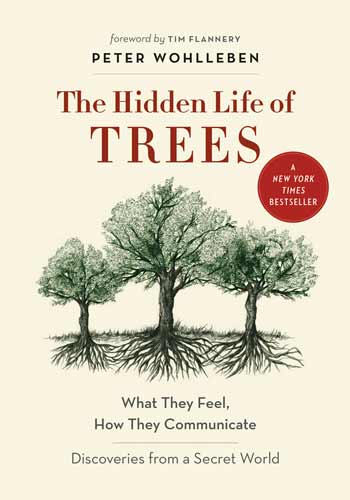B O O K R E V I E W
Seeing the Trees From the Forest Floor

The Hidden Life of TREES
By Peter Wohlleben
Greystone Books
Vancouver/Berkeley
272 pages; $24.95
In 2016 NOAA Fisheries officially recognized fish restoration in the Penobscot River watershed as essential to the restoration of the fisheries in the Gulf of Maine. That watershed comes out of and is created by one of the largest forested areas in the nation. The Gulf of Maine is one of the most extraordinary marine resources on earth. That this interdependence was not recognized by science until 2016 raises a few questions.
Just as it seemed we might be “out of the woods” with regard to understanding the preservation of these two resources, scientist and forester Peter Wohlleben has published The Hidden Life of Trees. Wohlleben brings another angle to the discussion of these two interdependent resources. It’s a positive development that science is acknowledging the role of the watershed in supplying fish, prey fish and nutrients to the Gulf of Maine. However, this book suggests the scale of the impacts that threatened the Gulf of Maine fisheries and the Penobscot watershed might need to be addressed regarding other impacts on the Maine forest. The forest that makes the Penobscot watershed possible.
Today Maine forests are being reduced to the equivalent of waste product to supply wood chip biomass to the world’s energy producers. Clear-cutting square miles at a time, the biomass industry mows all tree species into the chippers for the lowest price at the highest cost to the future of one of the largest remaining forested areas in the United States.
The Hidden Life of Trees is not about the Maine woods, but the habitat of all forest trees. Wohlleben is a scientist and forester in his native Germany where he cares for a forest of venerable beeches. He has worked in forests in many countries including the U.S. The habitat we see while walking through the woods is one part. More interesting is the habitat he describes which we don’t see below the surface of the forest floor. A tall tree of many tons that presents an enormous surface to hurricane winds, that may carry many additional tons of wet snow in a blizzard, requires a root system up to the task. It also needs a little help from its neighbors.
This help is a focal point of Wohlleben’s lifelong study of this hidden aspect of the life of trees. He describes a habitat where trees are, in a way, sentient, communal, supportive of their young and their neighbors. His matter of fact writing style, scientific knowledge and nine page bibliography of journal articles and scientific papers establish the book’s scientific foundation helping to deflect “tree hugger” charges.
For scale and comparison, he notes that trees can live 10 times longer than humans. He cites examining a “young” beech tree 1/3 of an inch in diameter that is 80 years old. Another was a small spruce in Sweden which researchers found to be 9,550 years old.
The habitat beneath the forest floor is an evolved, complex biological system that enables trees, among other things, to build a root system according the needs of the specific tree using the energy of the sun drawn down to its roots. Root systems intertwine with others. Miles of fungal networks function like chemical communication systems that wire root systems together. That fungal network was discovered in the early 1990s by researchers searching for clues to the remarkable fertility of Pacific northwest forests of the U.S. What they found was a constellation of fungi linking multiple tree species. The discovery was published in the journal Nature in 1997 and called the “wood wide web.” One such fungus was estimated to be 2,400 years old, extended over 2,000 acres and weighed 660 tons.
It’s long been known that clear-cuts open the previously shaded forest floor to the sun’s light and heat, changing the habitat and what can survive with those changes. Sending shiploads of Maine wood chip biomass to make electricity to air condition buildings on the other side of the planet is out there.
Without the forest and the floor in tact, erosion might fill the Penobscot watershed with muddy runoff that would empty into the Gulf of Maine, undermining restoration efforts.
Leaving a forest to do what it has been programmed to do is a tough sell in an industrial world that only values products. Wohlleben’s case for the forest being more than the trees suggests there might be a greater value for humans in letting the forest be more a forest.
The Hidden Life of Trees subtly and simply convinces the reader of Wohlleben’s conclusions about the life of trees. At the very least it is a new angle of view for readers interested in trees, the forest and possibly why.
